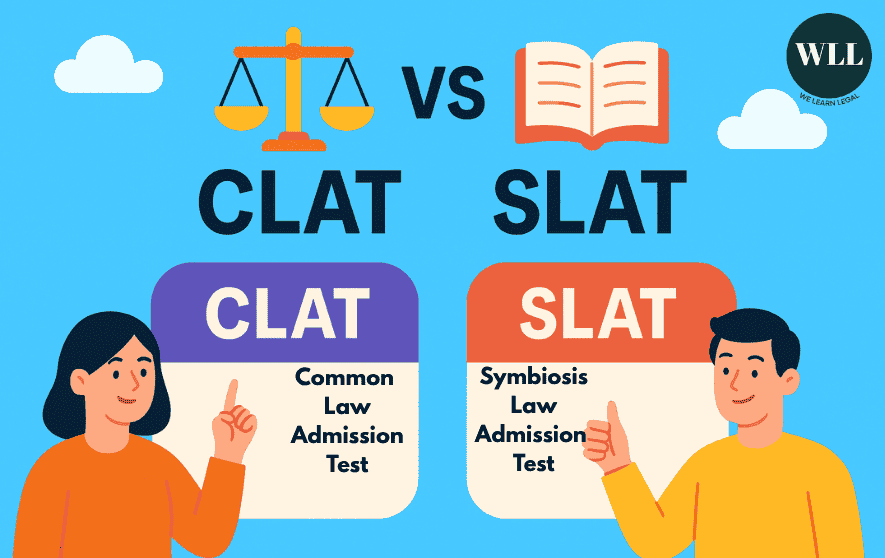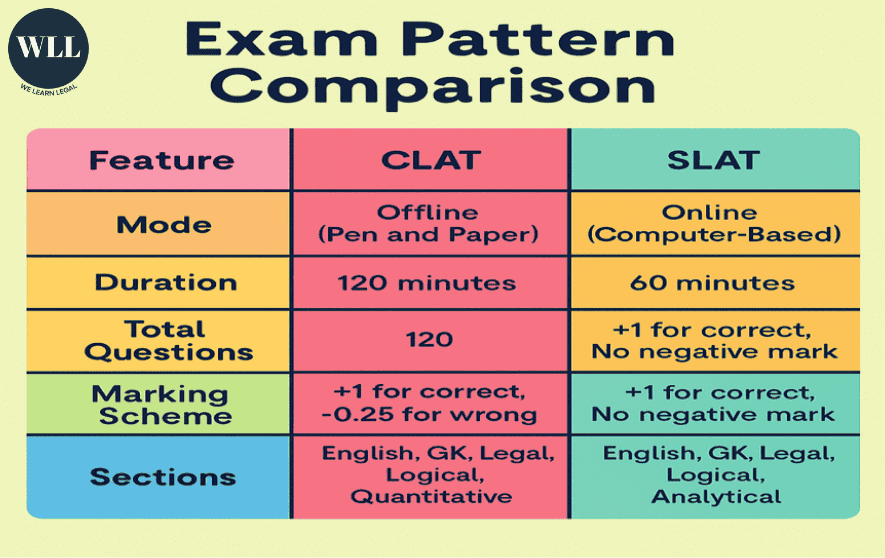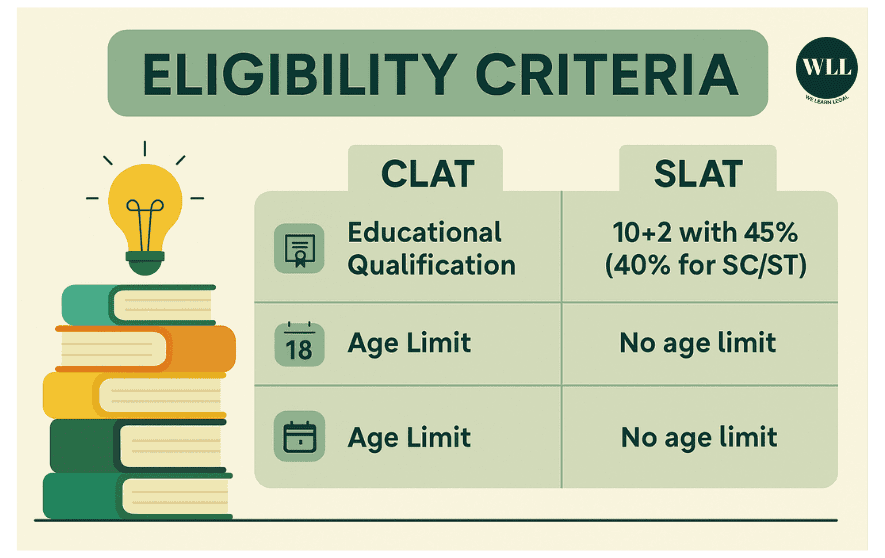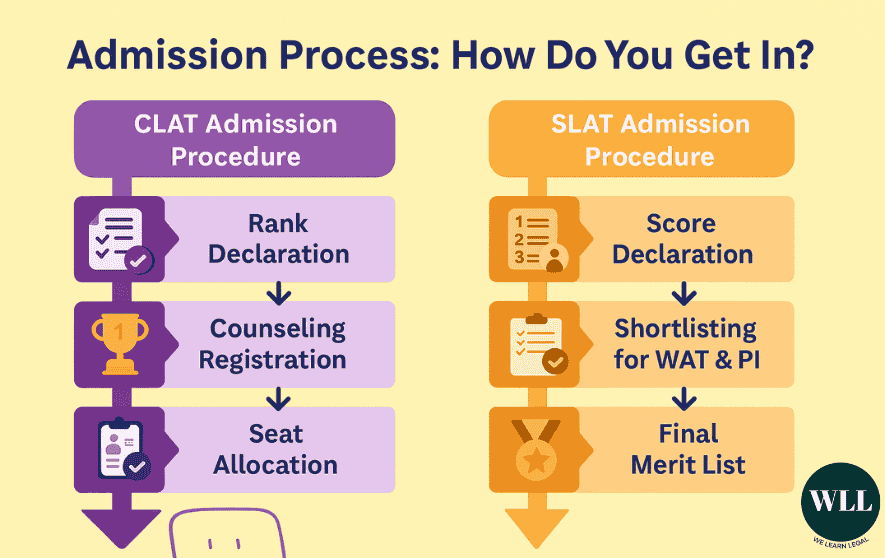In 2024, when CJI D.Y. Chandrachud made headlines for his tech-driven court reforms, and legal dramas like Sirf Ek Banda Kaafi Hai starring Manoj Bajpayee trended on OTT, one thing became clear — India’s legal profession is no longer confined to courtrooms and dusty files. It’s dynamic, impactful, and deeply interwoven with society. For thousands of young aspirants, the first step into this exciting world begins with a crucial choice: CLAT vs SLAT — two exams that open very different doors into India’s top law schools and shape distinct legal careers.
Every year, thousands of bright students across India dream of joining this world, inspired by news debates on constitutional rights, social media campaigns for justice, or even courtroom scenes in Bollywood. But before they can argue in court or draft landmark petitions, they face a crucial decision:

Which law entrance exam should I write — CLAT or SLAT?
The Common Law Admission Test (CLAT) is the gateway to 24 prestigious National Law Universities (NLUs), often called the “IITs of Law,” while the Symbiosis Law Admission Test (SLAT) leads to the renowned Symbiosis Law Schools under Symbiosis International University.
Both promise top-tier legal education, but they are fundamentally different in pattern, preparation, admission process, and even campus culture.
Imagine this choice like two distinct plots:
- One is a multi-starrer legal epic, packed with intense competition, all-India ranks, and a dash of courtroom glamour (think Jolly LLB).
- The other is a focused, private-university drama, known for global exposure, modern infrastructure, and a strong alumni network in corporate law (think The Trial starring Kajol, set in an elite law firm world).
This blog will help you navigate this choice confidently. We will break down:
✅ What is CLAT? What is SLAT?
✅ Exam patterns, eligibility, and syllabus comparison
✅ Which exam suits your career goals
✅ Preparation tips and topper insights
✅ FAQs that students like you often ask
Whether you dream of arguing in the Supreme Court, working with NGOs on human rights, or landing a job in a top law firm, understanding the CLAT vs SLAT battle is your first step.
So, let’s dive in and decode these two pathways — because choosing the right exam could shape not just your college life, but your entire legal career.
Understanding CLAT and SLAT
When you think about entering the legal world in India, two big names pop up on your radar — CLAT and SLAT. But what exactly are these exams? What do they offer, and why are they so important? Let’s break it down in a way that feels real, relatable, and relevant to you.
What is CLAT?
Full form: Common Law Admission Test
Conducted by: The Consortium of National Law Universities (NLUs)
Purpose: Admission to 24 National Law Universities and several other affiliated law colleges across India
Courses offered:
- 5-year integrated undergraduate law programs (BA LLB, BBA LLB, etc.)
- One-year LLM programs (postgraduate)
Now, let’s understand why CLAT holds such massive importance.
Imagine you’re watching the news: The Supreme Court has delivered a historic judgment on same-sex marriage rights, and the lead counsel quoted is a graduate from NLSIU Bangalore. A few days later, a viral Instagram Reel features a young advocate from NALSAR Hyderabad fighting for environmental protection in Goa. Where did these people start? Most likely, by cracking CLAT.
CLAT is often seen as the IIT-JEE of law. It’s fiercely competitive — over 60,000 aspirants appear every year, but only the top 3-5% make it to the top NLUs. These universities are known for producing top litigators, corporate lawyers, judges, academicians, and even policymakers.
The exam itself tests not just memory but sharp reasoning, reading comprehension, and problem-solving skills. It’s less about rote learning and more about how you think under pressure — much like the intense courtroom scenes we saw in Pink or Section 375, where a single argument can turn the case.
In short, CLAT is your golden ticket if you want to aim for the NLUs, which dominate India’s legal landscape.
What is SLAT?
Full form: Symbiosis Law Admission Test
Conducted by: Symbiosis International (Deemed University)
Purpose: Admission to Symbiosis Law Schools in Pune, Noida, Hyderabad, and Nagpur
Courses offered:
- BA LLB (Bachelor of Arts + LLB)
- BBA LLB (Bachelor of Business Administration + LLB)
On the other hand, SLAT offers a more specialized entry route.
Picture this: You’re watching The Trial on Disney+ Hotstar, where Kajol plays a former top-tier lawyer navigating complex corporate cases and ethical dilemmas. That world — of polished law offices, mergers and acquisitions, and corporate advisory — is where many Symbiosis graduates aim.
Symbiosis Law School (SLS) campuses are known for their strong industry connections, international exposure, and focus on corporate law, arbitration, and business law. While they don’t carry the “NATIONAL” tag like NLUs, they are respected brands, especially in the corporate sector.
SLAT is designed to test your English, analytical reasoning, legal reasoning, and general knowledge — but compared to CLAT, it has no negative marking and a slightly less intense competition pool (roughly 8,000–10,000 applicants per year).In summary, SLAT is your door to the Symbiosis ecosystem, where you get an education that balances law with business, offers internships with MNCs, and often leads to roles in corporate law firms, legal consulting, or in-house counsel positions.
Connecting the Dots
Both CLAT and SLAT open the door to exciting legal careers — but they cater to slightly different dreams. CLAT puts you on the track to join India’s elite public law universities, preparing you for litigation, judiciary, policy, and more. SLAT leads you into the private university space, where the focus is on a well-rounded, business-law-driven legal education.
Think of it like choosing between two movie genres:
- CLAT: A courtroom drama (Jolly LLB, Pink) where every argument can make or break you.
- SLAT: A corporate legal thriller (The Trial, Suits) where strategy, negotiation, and boardroom smarts rule.
In the next sections, we will break down how these exams compare on syllabus, difficulty, preparation strategies, and ultimately, which one aligns best with your legal ambitions. Stay tuned!
Consider these tips:💡
- Choose the right books — because random PDFs won’t cut it.
In the age of Telegram channels and YouTube playlists, students often feel lost in content overload. But toppers swear by specific, tried-and-tested books for each section.
Invest in quality over quantity: one good legal reasoning book, one solid GK source, one vocabulary booster, and reliable mock series.
👉 Explore our topper-recommended booklist
Exam Pattern Comparison
Once you understand what CLAT and SLAT stand for, the next big question is — how do these exams actually work? What’s the pattern, what’s tested, and how do they feel on exam day?
Let’s break it down like a real conversation, not a dry table — with examples you can relate to.
| Feature | CLAT | SLAT |
|---|---|---|
| Mode | Offline (Pen and Paper) | Online (Computer-Based) |
| Duration | 120 minutes | 60 minutes |
| Total Questions | 120 | 60 |
| Marking Scheme | +1 for correct, –0.25 for wrong | +1 for correct, No negative marking |
| Sections | English, GK, Legal, Logical, Quantitative | English, GK, Legal, Logical, Analytical |

Mode: Offline vs. Online
CLAT takes you back to pen and paper mode — yes, the old-school OMR sheet. Many students say it feels like writing the CBSE boards: the pressure, the ticking clock, the rustle of papers, the sharp look of invigilators. But there’s also comfort in scribbling notes in the margin or underlining key points.SLAT, on the other hand, is computer-based. Imagine sitting in a lab, clicking away on a mouse, with timers blinking on your screen. If you’re someone used to giving online mock tests or have attended online school during COVID, SLAT’s digital format might feel more familiar.
Duration: 2 hours vs. 1 hour
CLAT gives you 120 minutes to solve 120 questions — it’s a marathon. The challenge here isn’t just solving questions, but managing time across 5 intense sections. Many toppers say that the biggest hurdle is keeping focus for two straight hours, without slipping in speed or accuracy.SLAT, by contrast, is a 60-minute sprint. You have just one hour to tackle 60 questions. That means you get barely one minute per question, so thinking on your feet is essential. But here’s the good news — there’s no negative marking, so you can take calculated risks
Total Questions & Marking Scheme
CLAT:
- 120 questions, +1 for correct, –0.25 for wrong.
- The negative marking adds psychological pressure. One careless guess can cost you rank positions, just like a lawyer’s slip in court can damage a case (think of Jolly in Jolly LLB 2, when a hasty move almost cost him the case).
SLAT:
- 60 questions, +1 for correct, no penalty for wrong answers.
- This encourages smart guessing. If you’re unsure, you can mark an answer without fear — kind of like corporate negotiation scenes in The Trial, where taking a chance can either seal or lose the deal, but you won’t face courtroom punishment.
Sections: What’s Tested?
CLAT tests you in:
- English Language (comprehension-heavy)
- General Knowledge + Current Affairs
- Legal Reasoning (principle-fact, case studies)
- Logical Reasoning
- Quantitative Techniques (basic math, data interpretation)
SLAT tests you in:
- English Language
- General Knowledge
- Legal Reasoning
- Logical Reasoning
- Analytical Reasoning (patterns, series, puzzles)
Notice the difference? CLAT includes Quantitative Techniques, while SLAT replaces that with Analytical Reasoning. So if you’re math-phobic, SLAT might feel slightly kinder, but analytical reasoning comes with its own set of traps — like those puzzle scenes in Special Ops where one wrong link collapses the whole chain.
Syllabus Breakdown
Now that you know the exam pattern, let’s dive into what’s actually asked — the syllabus. Understanding the syllabus isn’t just about knowing topics; it’s about knowing what kind of thinking each exam rewards.
Let’s break it down section by section, using examples and analogies to make it crystal clear.
CLAT Syllabus
The Common Law Admission Test (CLAT) syllabus focuses on testing how well you understand, analyze, and apply information — not just memorize it. Here’s how:
English Language:
- Comprehension passages, vocabulary, grammar corrections, sentence rearrangement.
- It’s not “mug-up-the-meanings” — it’s about how well you understand context.
Example: A passage on the Uniform Civil Code debate might ask you to infer the author’s opinion, spot assumptions, or choose the right synonym.
Current Affairs including General Knowledge:
- National and international events, awards, government schemes, environment, sports, legal updates.
- This section tests your awareness, not depth.
Example: If you followed the Chandrayaan-3 moon mission or the Women’s Reservation Bill in Parliament, you’ll be better prepared.
Legal Reasoning:
- Principle-fact questions, basic legal terms, famous case laws.
- No prior legal knowledge is needed — it’s about applying the given principle to facts.
Example: Like in the film Article 15, where understanding constitutional rights mattered, here you apply a principle (say, “Every citizen is equal before law”) to a hypothetical situation.
Logical Reasoning:
- Critical reasoning, arguments, conclusions, assumptions.
- This tests your ability to think like a lawyer — spotting what strengthens or weakens a point.
Example: Like courtroom scenes in Pink or Mulk, where lawyers break down an opponent’s argument logically.
Quantitative Techniques:
- Basic maths (class 10 level), ratios, percentages, averages, data interpretation.
- You don’t need to be a math genius — just comfortable with numbers.
Example: Interpreting a chart on COVID-19 cases or calculating success rates from a table.
SLAT Syllabus
The Symbiosis Law Admission Test (SLAT) syllabus overlaps with CLAT in some areas but also has unique aspects.
English:
- Reading comprehension, grammar, vocabulary.
- Similar to CLAT, but with slightly less complex passages.
General Knowledge:
- Current events (politics, sports, awards), static GK (history, geography, science).
- Stay updated with newspapers, but also revise static topics.
Example: Knowing who won the 2024 Lok Sabha elections and who is the father of the Indian Constitution (B.R. Ambedkar).
Legal Reasoning:
- Legal terms, fundamental rights, legal aptitude.
- Less on application, more on knowing basic legal concepts.
Example: Terms like FIR, PIL, writ petitions — things you hear in the news or movies like Jai Bhim.
Logical Reasoning:
- Syllogisms, puzzles, analogies, series.
- More pattern-based questions.
Example: Completing series like “A is to B as C is to __”, or solving a seating arrangement puzzle.
Analytical Reasoning:
- Data interpretation, series completion, coding-decoding.
This is where your problem-solving speed matters.
Example: Like figuring out clues in a crime thriller (Drishyam style), you have to connect scattered data points quickly.
Consider these tips:💡
- Start with the syllabus — and actually understand it.
One big mistake aspirants make? Jumping into prep without deeply knowing what’s in the syllabus and how the two exams differ.
For CLAT, you’ll tackle comprehension-heavy passages, quantitative techniques, and principle-fact legal reasoning. For SLAT, you’ll focus on analytical reasoning and prepare for the WAT + PI stage.
👉 Check out our detailed syllabus guide here:
Eligibility Criteria
Before you start preparing for CLAT or SLAT, let’s address a crucial question: Are you eligible to write these exams?
Many students (and sometimes even parents) assume law entrance exams are only for students from certain streams or that there’s an age cap — but the truth is, both CLAT and SLAT are open and accessible to most aspirants right after Class 12.
Let’s break it down clearly.
| Criteria | CLAT | SLAT |
|---|---|---|
| Educational Qualification | 10+2 or equivalent with minimum 45% marks (40% for SC/ST) | 10+2 or equivalent with minimum 45% marks (40% for SC/ST) |
| Age Limit | No upper age limit | No upper age limit |

Educational Qualification
Both CLAT and SLAT require you to have completed Class 12 (10+2) from a recognized board — CBSE, ISC, State Board, or equivalent.
- Minimum Marks:
- General/OBC category: 45%
- SC/ST category: 40%
- General/OBC category: 45%
So, whether you’re from Science, Commerce, or Humanities — it doesn’t matter. What matters is that you clear 12th with the required percentage.
Example:
Let’s say you’re a Science student from Maharashtra State Board with 47% marks — you’re eligible.
Or you’re a Humanities student from CBSE with 42% marks, but you belong to SC category — you’re eligible.
Age Limit
Good news — there’s no age limit for appearing in either CLAT or SLAT.
This is important because we often see students who take a drop year or two to prepare better or those switching careers after a gap year. Unlike some competitive exams like NEET (where age limits apply), CLAT and SLAT are flexible.
Example:
If you were inspired by The Trial or Guilty Minds during your graduation and want to switch to law, you can! We’ve seen law aspirants aged 19, 20, even 22 crack these exams and enter top law schools.
Why This Matters
The open eligibility reflects an important truth about the legal profession in India today — it’s becoming diverse. We have engineers turned lawyers, social workers pursuing law for activism, and even young artists entering entertainment law.
As long as you meet the 10+2 criteria, you’re welcome to compete.In the next section, we’ll dive into which exam matches your career goals — because eligibility is just your entry ticket, but the real journey depends on where you want to go!
Participating Colleges: Where Will Your Score Take You?
Understanding which colleges accept CLAT and SLAT scores is essential — because your exam choice isn’t just about cracking a paper, it’s about where you’ll spend five transformative years of your life.
Let’s explore where these exams can take you.
CLAT Accepting Institutions
The CLAT is your gateway to 24 National Law Universities (NLUs) — India’s most prestigious public law schools, often called the “IITs of Law.”
Some of the top names include:
- NLSIU Bangalore — India’s first NLU, often ranked No. 1
- NALSAR Hyderabad — known for its academic rigor and beautiful campus
- WBNUJS Kolkata — top choice for corporate law enthusiasts
- NLU Jodhpur, NLU Bhopal, GNLU Gandhinagar, NLIU Bhopal, HNLU Raipur, RGNUL Patiala, and many more
Important note:
NLU Delhi does NOT accept CLAT. It has its own entrance exam, AILET.
Beyond NLUs, many private and government law colleges also accept CLAT scores for admissions, such as:
- Jindal Global Law School (partial consideration alongside LSAT)
- Institute of Law, Nirma University
- UPES Dehradun
- IFIM Law School, Bangalore
- ICFAI Law School, Hyderabad
In short, cracking CLAT gives you access to a wide network of top-tier law institutions across India.
SLAT Accepting Institutions
The SLAT score is exclusively accepted by Symbiosis Law Schools (SLS), which are part of Symbiosis International (Deemed University).
The participating campuses are:
- Symbiosis Law School, Pune — flagship campus, known for corporate law and international tie-ups
- Symbiosis Law School, Noida — strong presence in the Delhi NCR region
- Symbiosis Law School, Hyderabad — modern infrastructure and growing reputation
- Symbiosis Law School, Nagpur — newest campus, rapidly expanding programs
These schools are known for:
- Excellent industry connections, especially in corporate and business law
- Opportunities for international student exchange programs
- A vibrant private university culture with strong emphasis on extracurriculars and internships
Example:
If you dream of working with Big 4 consulting firms or top corporate houses right after law school, SLS Pune or Noida might offer the exposure you’re looking for.
Difficulty Level and Competition: How Tough Is the Battle?
One of the biggest concerns law aspirants have is — “Which exam is tougher, CLAT or SLAT?”
The honest answer? Both are competitive, but they challenge you in very different ways. Let’s unpack this carefully.
CLAT: The Tougher National Competition
CLAT is widely considered more challenging — and here’s why:
- Extensive Syllabus:
CLAT covers five major sections, including tricky areas like quantitative techniques and dense comprehension passages. You’re tested not just on knowledge, but on how sharply you analyze, interpret, and apply information. - Negative Marking:
With +1 for correct and –0.25 for wrong answers, CLAT demands accuracy and strategy. Guessing blindly can cost you. This adds psychological pressure — similar to a courtroom trial in a film like Jolly LLB, where every word counts. - Higher Competition:
CLAT attracts over 60,000–70,000 candidates every year, all fighting for roughly 3,000 seats in the NLUs. That’s less than 5% success rate for top colleges! You’re not just preparing to clear an exam — you’re preparing to outperform thousands of equally ambitious students.
SLAT: Moderate but Competitive
SLAT, by comparison, is more moderate in its level of difficulty:
- No Negative Marking:
You get +1 for correct answers, but no penalty for wrong ones. This allows more freedom to take calculated risks — a bit like making bold moves in corporate negotiations, as seen in The Trial. - Shorter Duration:
SLAT is just 60 minutes for 60 questions, making it a speed-based test rather than an endurance race. - Smaller Applicant Pool:
SLAT sees around 8,000–10,000 applicants every year, competing for seats across four Symbiosis campuses. While competition is still tough, the success ratio is better compared to CLAT.
Real-Life Angle
Think of it like this:
- CLAT is like aiming for a blockbuster Bollywood audition (think Ranveer Singh-level breakthrough) — super competitive, intense, but life-changing if you crack it.
- SLAT is like joining a polished OTT series with a strong cast (*think Sobhita Dhulipala in Made in Heaven) — selective, competitive, but more structured and specialized.
Consider these tips:💡
- Understand the exam — beyond just the paper.
Are you confused between CLAT, SLAT, or even AILET? Wondering if you’re eligible, or if dropping a year makes sense? Take time to understand the exam ecosystem, eligibility rules, and key differences — it will help you make smarter prep decisions.
👉 Compare exams here: CLAT vs AILET — Which is Better?
👉 Check eligibility criteria here:
Admission Process: How Do You Get In?
Cracking the entrance exam is just half the battle — the admission process that follows is what ultimately decides where you land. Let’s break down how CLAT and SLAT admissions work, step by step.

CLAT Admission Procedure
CLAT has a centralized, merit-based counseling process run by the Consortium of NLUs.
Here’s how it works:
CLAT Exam → Rank Declaration:
Once you write the CLAT exam, you receive an All India Rank (AIR) based on your performance.
Counseling Registration:
If you qualify, you register for centralized counseling on the CLAT portal, listing your NLU preferences (for example, NLSIU Bangalore as first, NALSAR Hyderabad second, and so on).
Seat Allocation:
Seats are allotted based on:
- Your rank
- Your category (General, SC, ST, OBC, etc.)
- Your college preferences
Admission Confirmation:
Once allotted, you either accept the seat, upgrade to higher preference (if available in later rounds), or exit the process.
Example:
If your AIR is 250, you might land at NUJS Kolkata; if your AIR is 1500, you might get HNLU Raipur or RMLNLU Lucknow.
The CLAT process is transparent and rank-driven, much like other top national-level exams like NEET or JEE.
SLAT Admission Procedure
SLAT has a multi-stage selection process run individually by each Symbiosis Law School (SLS) campus.
Here’s what happens:
SLAT Exam → Score Declaration:
You write the SLAT online test, and results are announced soon after.
Shortlisting for WAT & PI:
Based on your SLAT score, you are shortlisted for:
- Writing Ability Test (WAT): An essay-type test to assess your written communication, critical thinking, and clarity of expression.
- Personal Interview (PI): An interaction with faculty panels to evaluate your motivation, personality, general awareness, and communication skills.
Final Merit List:
Your final selection is based on:
- SLAT Score
- WAT Performance
- PI Performance
Example:
Even if you score modestly in SLAT, a brilliant WAT essay or confident PI can boost your final chances — making the process more holistic.
Key Takeaway
- CLAT: Purely merit + preference-based centralized admission, no interviews or essays.
- SLAT: Combination of entrance score + written test + personal interview, emphasizing all-round personality.
It’s like two kinds of casting:
- CLAT is like getting a film role purely on box office numbers (rank),
- SLAT is like getting picked for a show based on audition performance + screen test + portfolio.
Fee Structure Overview: What Will It Cost You?
When choosing between CLAT and SLAT, one practical — and very important — factor is the fee structure. Law school is not just an academic investment; it’s also a financial one, and understanding the costs upfront helps you and your family plan wisely.
Let’s break down the approximate fee ranges for NLUs and Symbiosis Law Schools
| Institution Type | Approximate Fee Range (per annum) |
|---|---|
| NLUs (via CLAT) | ₹1.5 Lakhs to ₹3 Lakhs |
| Symbiosis Law Schools (via SLAT) | ₹3 Lakhs to ₹4 Lakhs |
NLUs (via CLAT)
The 24 National Law Universities (NLUs) have fees that generally range between ₹1.5 to ₹3 lakhs per year, depending on the university.
For example:
- NLSIU Bangalore, NALSAR Hyderabad, NUJS Kolkata — fees on the higher side, around ₹2.5–₹3 lakhs/year.
- NLU Jodhpur, GNLU Gandhinagar, HNLU Raipur — slightly lower, often ₹1.8–₹2.5 lakhs/year.
What’s included?
Tuition fees
Hostel and mess charges
Library, exam, and other academic fees
Important: Since NLUs are government-run, their fees are regulated and subsidized, which makes them more affordable compared to many private institutions.
Symbiosis Law Schools (via SLAT)
Symbiosis Law Schools — Pune, Noida, Hyderabad, Nagpur — typically charge ₹3–₹4 lakhs per year.
For example:
- SLS Pune (flagship campus) — around ₹4 lakhs/year
- SLS Noida, Hyderabad, Nagpur — around ₹3–₹3.5 lakhs/year
What’s included?
Tuition fees
Hostel (optional, varies by campus)
Development and academic fees
Being part of a private deemed university, Symbiosis charges higher tuition fees, but offers a modern campus, international exposure, and sometimes more diverse extracurricular facilities.
Real-Life Lens
Think of it like this:
- CLAT NLUs are like getting into a top government college — competitive, prestigious, and more cost-effective.
- SLAT Symbiosis schools are like joining a premium private university — polished, resource-rich, but costlier.
Example: If you watched Taare Zameen Par, you’d remember how schools vary in their fee culture; similarly, your law school choice will impact both your financial planning and the resources you get.
💡 Pro Tip: Plan Your Legal Journey Smartly!
- Law school isn’t just an academic decision — it’s also a financial and career investment. Before you choose between NLUs through CLAT or Symbiosis Law Schools through SLAT, take time to explore not just fees, but also scholarships, ROI (placements), campus culture, and long-term growth.
- Want help navigating it all?
- 👉 Visit WeLearnLegal — your one-stop guide for law entrance prep, college insights, topper interviews, and free resources to plan your dream legal career with confidence!
Career Opportunities Post Graduation: Where Can Your Law Degree Take You?
Choosing between CLAT and SLAT isn’t just about the exam or the campus — it’s about where you want to go after graduation. Both NLUs and Symbiosis Law Schools offer excellent career paths, but they often lead you into different kinds of legal careers.
Let’s explore what life looks like after you earn that law degree.
After CLAT
Graduating from an NLU opens doors to some of the most prestigious and diverse career options in India’s legal landscape.
Judiciary Exams:
Many NLU graduates prepare for Judicial Services Exams (PCS-J) to become civil judges or magistrates. The strong academic foundation at NLUs, combined with exposure to moot courts and legal aid clinics, makes them well-prepared for this path.
Litigation:
NLU alumni are often seen practicing at the High Courts, Supreme Court, and district courts. Some join senior advocates or law chambers, while others start their independent practice, like we saw in Section 375 or Pink — where young lawyers fight landmark cases.
Corporate Law Firms:
Top-tier law firms like AZB & Partners, Shardul Amarchand Mangaldas, and Cyril Amarchand Mangaldas actively recruit from NLUs, offering lucrative packages for roles in mergers, acquisitions, banking, capital markets, etc.
Academia & Research:
Many NLU graduates pursue higher studies (LLM, PhDs) in India or abroad, going into teaching, policy research, or think-tank roles.
Public Policy & Government:
Some graduates work with ministries, international organizations, NGOs, or policy consultancies — driving legal reforms and social change.
Example:
Recent NLU graduates have worked on gender rights legislation, environmental law, and even assisted in Supreme Court constitutional benches.
After SLAT
Symbiosis Law School graduates shine especially in corporate and entrepreneurial spaces, thanks to the institution’s strong industry linkage and practical orientation.
Corporate Sector:
SLS graduates often join corporate legal teams, MNCs, banks, fintech, and startups as in-house counsels or compliance officers.
Legal Consultancy:
Many go into consulting roles, arbitration, and mediation, supporting businesses with legal strategy, contracts, and regulatory compliance.
Entrepreneurship:
With their blend of law and business exposure, some SLS alumni launch legal-tech startups, boutique law firms, or advisory firms.
Higher Studies & International Opportunities:
Symbiosis’s global connections help graduates pursue LLMs or fellowships abroad in areas like international business law, intellectual property, or human rights.
Example:
An SLS Pune alum might end up as a corporate lawyer negotiating billion-rupee deals, or as a legal advisor for a top media house — think of a character like Kajol in The Trial.
Big Picture Takeaway
- After CLAT (NLUs): Broad pathways across litigation, judiciary, corporate law, academia, and public policy.
- After SLAT (Symbiosis): Strong focus on corporate law, legal consultancy, entrepreneurship, and global opportunities.
Neither is “better” — it depends on your personality, dreams, and vision for your legal career.

Which Exam Should You Choose: CLAT vs SLAT?
After all this comparison, the big question remains — CLAT vs SLAT: which exam is right for YOU?
Remember, this is not just an entrance test decision; it’s the first step toward shaping your five years of law school and the decades of legal career that follow.
Let’s break it down carefully.
Choose CLAT if…
You want to aim for the National Law Universities (NLUs) — India’s top-tier public law schools, known for producing top litigators, judges, bureaucrats, and legal scholars.
You dream of a career in litigation, judiciary, public policy, or academia.
NLUs offer a robust academic foundation, exposure to national-level moots, internships with senior advocates, and preparation-friendly environments for judicial services and UPSC.
You are ready to take on the challenge of a highly competitive, negative-marking exam with a vast syllabus and thousands of aspirants.
Example:
If your ambition is to argue landmark cases in the Supreme Court or draft laws that shape the nation, CLAT is your battlefield.
Choose SLAT if…
You’re interested in joining Symbiosis Law Schools (SLS) — reputed private institutions with a strong focus on corporate law, business, and global exposure.
Your career goals lean toward the corporate sector, legal consultancy, or entrepreneurship.
SLS offers excellent industry linkages, placement support, and opportunities for international internships or LLMs abroad.
You prefer a moderate-difficulty exam without negative marking, where you can also showcase your personality and communication skills through WAT and PI.
Example:
If you see yourself working as an in-house counsel for a tech giant or advising MNCs on complex deals (like Kajol in The Trial), SLAT may be your best fit.
CLAT vs SLAT: Key Factors to Consider
- Exam Difficulty: CLAT is tougher, longer, with negative marking; SLAT is shorter, faster, risk-friendly.
- Preferred Colleges: CLAT → NLUs; SLAT → Symbiosis Law Schools.
- Career Goals: CLAT → Litigation, judiciary, public service; SLAT → Corporate law, consulting, business law.
- Preparation Time: CLAT prep often starts earlier (Class 11 or 12), while SLAT can be targeted with 6–12 months of focused study.
FAQs on CLAT vs SLAT: Your Most Asked Questions Answered
Which is tougher — CLAT or SLAT?
CLAT is generally considered tougher because of:
A larger syllabus
Negative marking
National-level competition with over 60,000 aspirant
SLAT is more moderate, with no negative marking and a shorter paper. However, it also includes WAT and PI rounds, which need preparation.
Can I prepare for CLAT and SLAT together?
Yes!
Since the core subjects (English, GK, Legal, Logical) overlap, you can prepare for both together. Just remember:
For CLAT, focus on quantitative techniques and deep comprehension.
For SLAT, practice analytical reasoning and prepare for the WAT + PI stage.
Do NLUs accept SLAT scores?
No.
NLUs only accept CLAT scores (except NLU Delhi, which uses AILET).
SLAT scores are accepted only by Symbiosis Law Schools (Pune, Noida, Hyderabad, Nagpur).
Which exam is better for a career in corporate law?
Both can lead to corporate law careers, but:
SLAT/Symbiosis is more corporate-law focused, with strong MNC connections.
CLAT/NLUs also place graduates in top corporate firms but offer a broader career scope (litigation, judiciary, policy, academia).
Is there any age limit for CLAT or SLAT?
No.
Both exams have no upper age limit. You just need to have passed Class 12 with the required percentage (45% for General, 40% for SC/ST).
Conclusion: CLAT vs SLAT — Choose Your Path with Confidence
Choosing between CLAT and SLAT is not just about selecting an exam — it’s about choosing the direction of your legal journey.
If you see yourself arguing landmark cases, preparing for the judiciary, shaping public policy, or joining India’s top law firms, CLAT and the NLUs may be your calling.
If you’re drawn to the corporate world, international business law, legal consultancy, or even launching your own legal startup, SLAT and Symbiosis Law Schools offer a fantastic platform with modern training and global exposure.
Remember, there’s no “better” exam — only the one that aligns with your dreams, strengths, and personality.
Whichever path you choose, commit fully, prepare smartly, and believe in your potential. Because whether you step into a Supreme Court chamber or a corporate boardroom, the Indian legal world needs young, passionate minds like yours.








